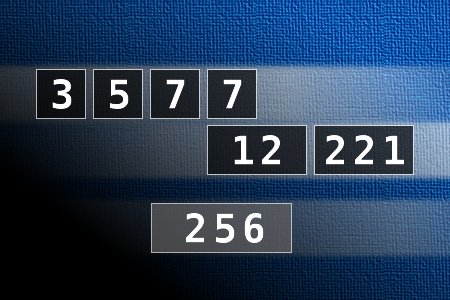Calculate the number 256
NUMBERMANIA: Calculate the number 256 using numbers [3, 5, 7, 7, 12, 221] and basic arithmetic operations (+, -, *, /). Each of the numbers can be used only once.
26 funny new Thanksgiving jokes
Q: What happens when you're too harsh on cranberries and make them sad?
A: They turn into blueberries.
Q: What's the difference between Election Day and Thanksgiving?
A: On Thanksgiving, you get a turkey for the day. On Election Day, you get a turkey for four years.
Q: Why did the turkey cross the road?
A: It was Thanksgiving Day and he wanted people to think he was a chicken!
A first grade class was asked to write a paragraph called "What I'm thankful for on Thanksgiving."
Little Johnny's began, "I am thankful that I'm not a turkey."
Q: When did the Pilgrims first say, "God bless America?"
A: The first time they heard America sneeze.
Q: What do you call Thanksgiving if you're selfish?
A: Thanks-taking.
My husband doesn't think housework is a full-time job. So for Thanksgiving, I served him a raw turkey because revenge is a dish best served cold.
Why did the farmer run a steamroller over his potato field on Thanksgiving Day?
He wanted to raise mashed potatoes.
Q: What do you get when you cross a turkey with a banjo?
A: A turkey that can pluck itself!
Q: What did baby corn say to mama corn?
A: Where's popcorn?
Q: What did the turkeys sing on Thanksgiving Day?
A: God save the kin.
Q: What did the turkey say to the turkey hunter on Thanksgiving Day?
A: Quack! Quack!
Q: Which part of the turkey do drummers prefer?
A: The drumstick, or course!
Q: What's the main ingredient in Thanksgiving bread?
A: May-flour!
Q: Where's the only place that Christmas comes before Thanksgiving?
A: In the dictionary!
Q: What's a pumpkin's favorite sport?
A: Squash!
Q: What do you call it when it rains turkeys?
A: Foul weather!
Q: What sound does a turkey's phone make?
A: Wing, wing.
Q: What's the smallest unit of measurement in the pilgrim cookbook?
A: Pilgram.
Q: How did Albert Einstein celebrate Thanksgiving?
A: He was very thinkful.
Q: Why did the Pilgrim eat a candle?
A: He wanted a light snack.
Q: Why was the cook late to Thanksgiving dinner?
A: He lost track of thyme.
Q: Why did the turkey sit on the tomahawk?
A: To try to hatchet.
Q: Why do turkeys lay eggs?
A: Because if they dropped them, they would break.
Q: If fruit comes from a fruit tree, where does turkey come from?
A: A poul-tree.
Q: What do you get when a turkey lays an egg on a hill?
A: An eggroll.

